If I asked you what the most bombed country in the world was, what would you say? Most likely, Laos wouldn't even be on your radar. Here's why you're wrong, and why we considered saying we're from Canada when visiting Laos.
Did you know that from the mid 1960s until 1973 America engaged in a Secret War in Laos? Without the consent or knowledge of Congress, we dropped over two million tons of bombs on a country that consisted mostly of rice paddies and farmers.
Even the soldiers in Vietnam didn't know that the war they were fighting crossed country borders, but cross them it did. In direct violation of the Geneva Convention, the US spent over $2 million a day (in 1960s money) in an unsuccessful effort to stop what they saw as the spread of Communism. The CIA trained and outfitted Hmong guerrillas to wage war against the Pathet Lao, the group that was assisting the Viet Cong and spurring the Communist takeover in humble Laos. Some of the bombing America did in Laos was to stop Vietnam from moving supplies to the Viet Cong in South Vietnam, but much of it had a less noble purpose. When missions in Vietnam were cancelled, pilots were instructed to drop their bombs on Laos en route to their Thailand bases. Landing planes with bombs was difficult and time-consuming. Dropping them on rural villages where cows grazed was much easier.
We knew nothing about this war until we bought our guidebook and to say we were shocked would be an understatement. Having traveled through Laos for about two weeks before we got to Vieng Xai made it even crazier. This is a third-world country full of poor people, the majority of whom live on less than $1.25 a day. Why in the world did America drop more bombs here than were dropped during WWII?
It's strange to say, but the worst thing about the bombs is that many of them didn't work. Experts estimate that about 30% failed to detonate, which means rural Laos is covered in unexploded ordinance (UXOs). Despite being incredibly scary, this simple fact also keeps the country poor. Farmers are scared to farm new land, since many of them have lost friends, family members, or limbs when their hoes hit "bombies." In the villages around Phonsavan, we saw children who only had one eye, men with one leg, etc. They weren't fighting the war and the US wasn't fighting them, but the bombs found them either way—four decades later. (On a side note, you can't trek independently in this area because so much of the land hasn't been cleared. I can tell you from personal experience that I'd never been as scared as when we lost our way on our motorbike and ended up in a field. Sweating from fear makes history personal.)
The US is now offering some assistance in the cleanup effort but most of it is being financed, per the usual, by private corporations. MAG, with an office in Phonsavan, has trained several groups of locals to become bomb diffusers. Donate money to the effort on MAG's website.
See and Do and Activities
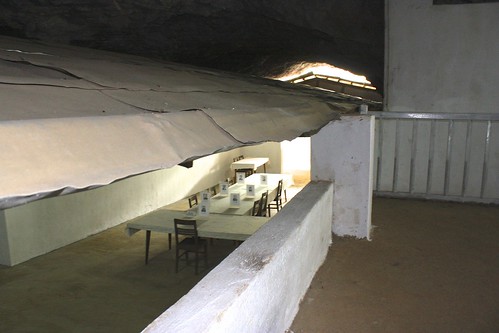
Nowhere are the remnants of the Secret War more evident than Vieng Xai, the birthplace of the Pathet Lao. It's here that the leaders of the new government hid during the Secret War and it's here where they "beat" America. Vieng Xai is a beautiful place, fringed by stone cliffs that hide deep caves that once housed thousands of people, schools, hospitals, and government offices.
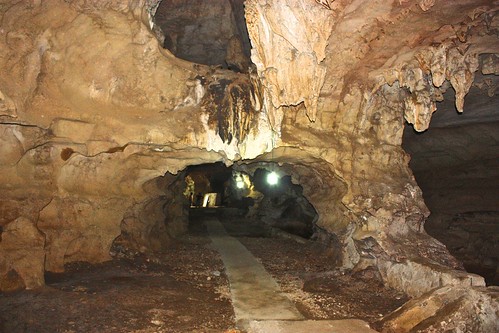
Visiting these caves was, unexpectedly, our favorite part of our trip to Laos. Tours start at 9am and 1pm and you're accompanied by a guide and a fabulous audio tour. As you go from cave to cave, visiting the former "homes" of the seven men that made up the Pathet Lao leadership, it's hard not to be impressed. Each cave has several bedrooms, a boardroom, and a panic room, complete with oxygen pumps that take bad air out and bring good air in. Some caves are sheltered by bomb walls, while others show visible damage from rockets that almost made it inside.
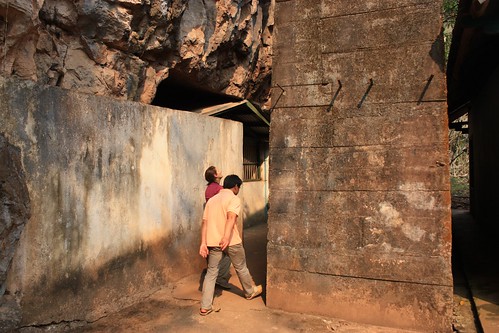
Oh... and we almost forgot the theater.
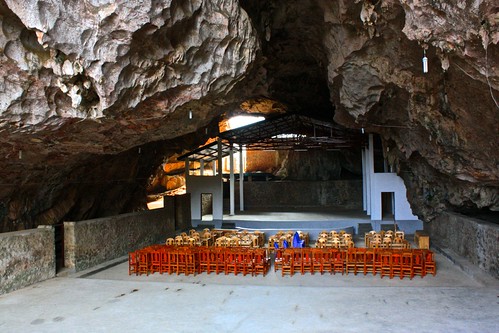
There is interesting Communist paraphernalia, including a bust of Lenin donated by the Russian government and several books (in different languages) about the history of socialism.
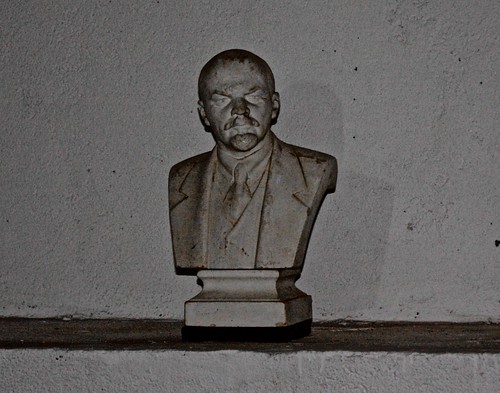
TIP: Visit Vieng Xai by motorbike to see more caves
If you opt for public transport, rent a bike once you're there. Otherwise your 60,000K entry fee won't go very far.
One thing is clear: the men who started the Pathet Lao movement were incredibly educated, well-read, and convinced that a break from French rule and royal government was the best way to move their country forward. They also seemed to have unparalleled agreement between them. We were surprised to realize that the men who began the revolution were also those that ruled the country, in succession, until a few years ago when the last one died.
The US bombing stopped in 1973, which was the year the leaders came out of their caves. But instead of leaving Vieng Xai, they each commissioned a house to be built in front of the cave that secured both their livelihood and their new form of government. Seeing the beautiful houses in exquisitely landscaped gardens is a strange paradox, but the Lao seem to have an inherent sense of irony. The man known as the Red Prince, a royal who joined the Pathet Lao movement, converted the bomb crater in front of his house to a heart-shaped swimming pool.

The one thing that stuck with us most was the wording at the end of the audio tour. While I can't remember it verbatim, it was essentially this: "Even the strongest country in the world couldn't stop the Lao people from choosing the government they wanted." Why we tried continues to be less obvious.
Sleep
It's difficult to get to Vieng Xai in one day from Phonsavan, so most people end up staying in Sam Neau. The place is full of similar hotels on the riverfront, so just pick one. We ended up at Bounhome. It was 80,000K/night and they weren't willing to budge on price. The shower sucked, but they did have free Nespresso.
TIP: This area of the country is COLD
If you're leaving your big bag in Phonsavan, make sure you bring a jacket and long pants in your day pack. If you're planning to motorbike, bring a scarf.
Eat and Drink and Drink
UGH. I hate to even call it a restaurant, but the only place to eat in Sam Neau is right next to Bounhome and it's average at best.
In Vieng Xai, there's an Indian restaurant on the same street as the Caves Visitor Center. We ate there twice in five hours. The name is Sabaidee Odisha, but it's hard to see on the sign, so ask around if you can't find it.

Transport
The best way to get to Vieng Xai from Sam Neau is by motorbike. At 60,000K, it's also the cheapest option and allows you to stop off at Nok Ann Cave, a beautiful cave with some history and nature to make it worth the 10,000K entrance fee. We didn't take the boat ride, but if you're not going to Kong Lor, you should. The family that runs this place is also incredibly sweet. They gave us the most delicious purple potatoes to snack on!
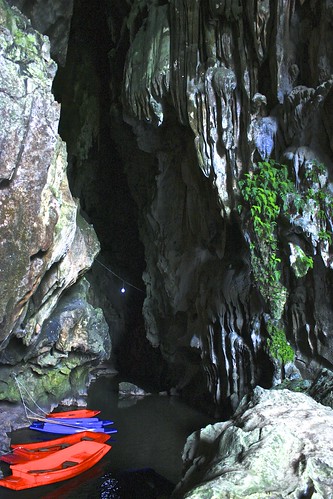
If you are driving, just follow the main road across the bridge from Sam Neau. The only turn comes about 20 kilometers in and isn't signposted. When you see a paved road on the right, go right with it! If you miss the turn like we did, following the main road straight, then your way back gives you a beautiful view of the super high waterfall. Either way, it's a beautiful sinewy drive full of jutting black cliffs appearing amidst the fog.
From Sam Neau, you either go backwards to somewhere in Laos or cross into Vietnam. The repeat of our bus ride to Phonsavan was better (and shorter) than the way there.
TIP: Get off the bus in town if you can
Laos bus stops are purposefully located away from the city center, but if the bus goes through town, you can get on and off there, saving you the cost and time expense of heading to the station. The bus from Sam Neau to Phonsavan does just this, so ask to be let off in town.
More on the Secret War
See more photos of the caves the Pathet Lao lived in during the Secret War. You may also be interested in reading about Phonsavan, where many people are still affected by UXOs from the Secret War.
Which part of the story did you find most shocking? Let us know in the comments.
Comments